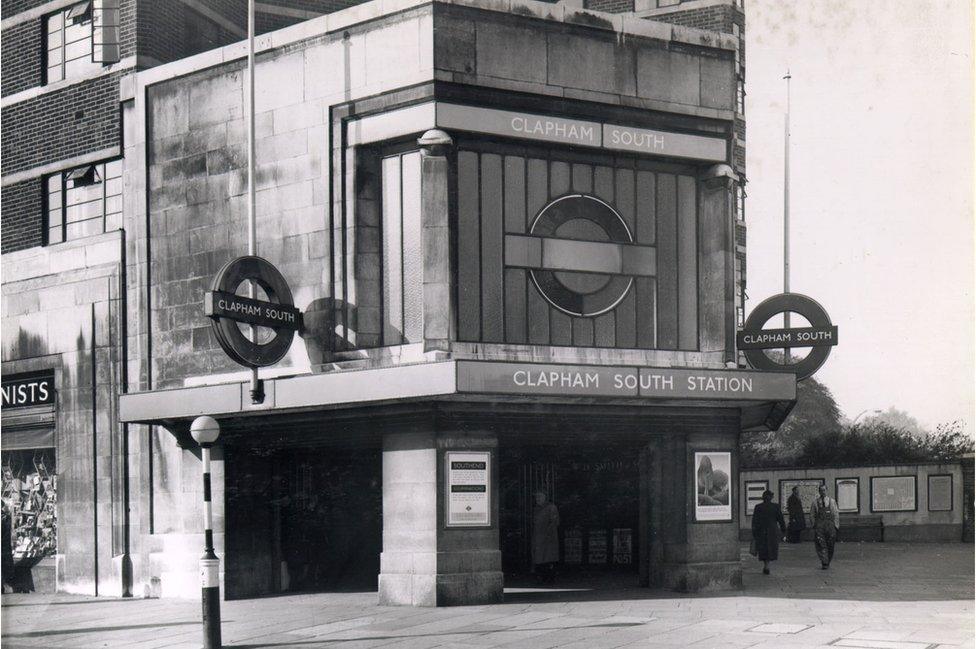Going underground: The Windrush arrivals' subterranean dormitories
- Published

John Richards (far right) remembers "beds all around with crisp white sheets"
When Caribbean migrants stepped off MV Empire Windrush on 22 June 1948, many had nowhere to live. The lack of housing in London following World War Two meant even temporary accommodation was in short supply.
So 236 migrants from the merchant vessel were bussed from Tilbury docks in Essex to Clapham, where for six shillings and sixpence a week they got food and a bed in a shelter underneath Clapham South Tube station.
The underground passages had been fitted with bunk beds and washing facilities when they were used as civilian shelters during the war.
Life in the windowless underworld was basic, cramped and noisy. One Windrush resident described the accommodation as "primitive and unwelcoming, like a sparsely furnished rabbit's warren".
They tried to sleep as trains rattled overhead.
Now the London Transport Museum has opened up the deep-level site for tourists to explore on guided tours.

A labyrinth of tunnels under Clapham South Tube station provided shelter during World War Two before becoming accommodation for passengers leaving the SS Windrush

The Ministry of Labour and National Service Office set up on site at Clapham South underground shelter on 23 June 1948

The new arrivals were interviewed by the Ministry of Labour and National Service Office to help them find work
One of the subterranean suburbanites was John Richards, now 92. He lived underground for three weeks when he first arrived in London after the Windrush docked at Tilbury.
"The trains that ran overhead in the morning woke me up. There were beds all around with crisp white sheets.
"They had a tea cart at the station. We had pie in the evenings," said Mr Richards, who soon moved into a hostel and found work with British Rail.
"I survived, because friends know friends. It was hard but in the long run you find a way."

The Daily Express reported at the time: "All of them sat down to their first meal on English soil: roast beef, potatoes, vegetables, Yorkshire pudding, suet pudding with currants and custard"

A canteen was set up for the Windrush residents. Pie was a popular dish

Accommodation and meals cost 6s.6d. (33p) a day. Most of the passengers from Jamaica had £5 to last them until they found work
The tunnels of Clapham South are the deepest of the deep-level shelters, and sit beneath the Northern line. There are 180 steps down to reach it and there were enough beds for 8,000 people.
The shelter was never used to capacity - it opened to members of the public in 1944, after the worst of the Blitz.
What was life like for first-generation Windrush migrants?
Original 1940s signage remains on the walls, including directions to the toilets, canteen and sleeping areas.
Those seeking shelter were assigned to a specific section of Clapham South, each of which was named after a famous British admiral, including Collingwood, Drake and Jellicoe.

Signs from the 1940s remain on the tunnel walls

The big mound on the right is the spoil heap that resulted from digging out the shelter

John Richards, now 92, recently visited the tunnels for the first time since he left 70 years ago. He is pictured in several archive photographs taken at the time of his arrival in London
Within four weeks of arriving, all the Windrush migrants had secured jobs and moved out of the site.
One of the biggest employers was London Transport.
Many workers eventually settled in nearby Brixton, the site of the nearest labour exchange, beginning the area's association with Caribbean culture.

Mr Richards (in the stripy suit) on board the SS Empire Windrush as it came into Tilbury Docks. He was a 22-year-old carpenter

On 24 May 1948 the SS Empire Windrush left Kingston, Jamaica with nearly 500 passengers. It docked at Tilbury in Essex on 21 June 1948

During the war, thousands of men and women from the Caribbean had served in the armed forces. When the SS Empire Windrush stopped in Jamaica to pick up servicemen, many people, having seen the Daily Gleaner newspaper advertising the journey for £28.10, decided to travel to Britain
The Windrush passengers were not the last to use the tunnels of Clapham South as somewhere to bunk down.
In 1951 the tunnels were open to thrifty visitors to the Festival of Britain, external who wanted somewhere cheap to stay in the capital as they viewed the new Festival Hall, the Skylon and Donald Campbell's Bluebird.
The site was also used as a billet for troops lining the route for the funeral of George VI in 1952 and for Coronation visitors in 1953.

A canteen established in World War Two was brought into service again for the Windrush residents

The air raid shelters under Clapham South could only be accessed by people with an admittance ticket

The canteen was also used for visitors to the Festival of Britain
Tickets to see the underground shelters, external are now on sale from the London Transport Museum for tours starting on 11 August, running Wednesdays to Sundays.
- Published18 June 2018
